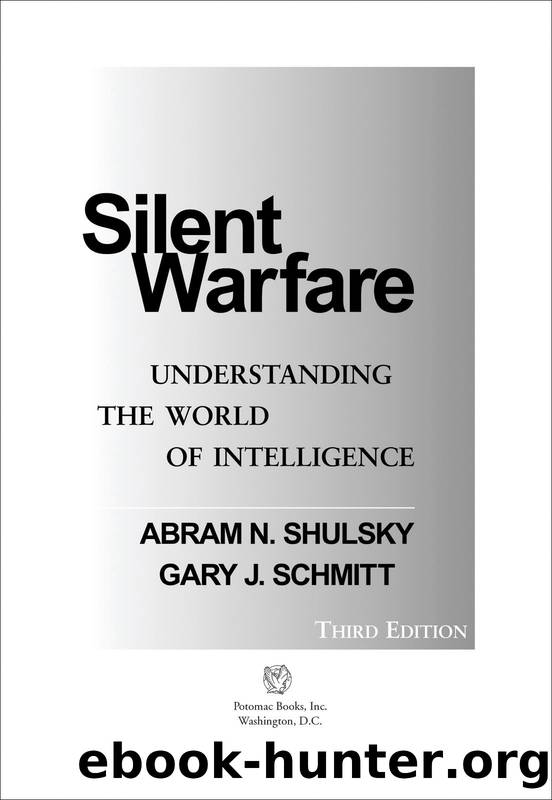Silent Warfare by Abram N. Shulsky & GARY J. SCHMITT

Author:Abram N. Shulsky & GARY J. SCHMITT
Language: eng
Format: epub
Publisher: Potomac Books, Inc.
Published: 2002-11-15T00:00:00+00:00
COUNTERINTELLIGENCE ANALYSIS
As the discussion of double agents and deception indicates, protecting the integrity of intelligence operations can become very complicated, involving much more than catching the occasional spy. In fact, cases may be linked to each other in various ways; the overall task of guarding an intelligence apparatus against penetration and deception requires a special counterintelligence analysis office to serve as an institutional memory and analyze these connections.
The best way to determine whether oneâs intelligence apparatus has been penetrated is to acquire a high-level source in the hostile service (either an agent in place or a defector). Even then, however, it would be a rare stroke of luck if the source could identify by name the spies in oneâs ranks. This would be the case only if the source were directly involved in handling them or were a very high-ranking officer of the hostile service. In the much more likely scenario, the source will be able to provide only clues to the spiesâ identities. Analytic work will be necessary to make those clues yield results.
For example, one may discover that the adversary has had access to several classified documents on a subject. Assuming they all came from the same agent, one could review the distribution lists for the compromised documents and note which officials had access to all of them. Alternatively, the source may know that the spy held a meeting with his handler in a certain foreign city on a specific date. Reviewing travel records would indicate which officials with access to relevant information were in that city then.
In addition, other clues may be available that suggest penetrations of some sort. Thus, if oneâs operation fails (an agent is discovered or a technical collection system is thwarted) in a way that suggests the adversary had been aware of the operation before it took place, it is necessary to investigate how he may have learned of it. There will no doubt be many avenues (individuals with access to the information, as well as security vulnerabilities or lapses) by which the information could have reached the adversary. If there is a series of such failures, however, it may be possible to narrow the options; for example, maybe only one particular individual had been authorized access to all of the information. On the other hand, a series of failures may also indicate that a communication channel or system has been compromised. For instance, from the late 1960s through the early 1980s, U.S. Navy officials were routinely surprised to find Soviet ships waiting for American warships in areas that had been secretly designated for exercises. One admiral was quoted as saying, âIt is as if they had a copy of the OpPlans.â But it was not until the espionage ring of John Walker was discovered in 1985 that the United States learned that naval cipher materials were being regularly given to the Soviets and hence that large amounts of enciphered naval message traffic were possibly being read by them.69 In any event, such
Download
This site does not store any files on its server. We only index and link to content provided by other sites. Please contact the content providers to delete copyright contents if any and email us, we'll remove relevant links or contents immediately.
| Biological & Chemical | Conventional |
| Nuclear |
The Radium Girls by Kate Moore(10923)
The Templars by Dan Jones(4197)
100 Deadly Skills by Clint Emerson(4090)
Rise and Kill First by Ronen Bergman(4026)
The Doomsday Machine by Daniel Ellsberg(3742)
The Rape of Nanking by Iris Chang(3530)
Killing England by Bill O'Reilly(3466)
Hitler in Los Angeles by Steven J. Ross(3450)
Stalin by Stephen Kotkin(3094)
12 Strong by Doug Stanton(3064)
Hitler's Monsters by Eric Kurlander(2740)
Darkest Hour by Anthony McCarten(2655)
Blood and Sand by Alex Von Tunzelmann(2615)
The Art of War Visualized by Jessica Hagy(2424)
Hitler's Flying Saucers: A Guide to German Flying Discs of the Second World War by Stevens Henry(2305)
The Code Book by Simon Singh(2222)
The Second World Wars by Victor Davis Hanson(2140)
Babylon's Ark by Lawrence Anthony(2077)
Tobruk by Peter Fitzsimons(2068)
